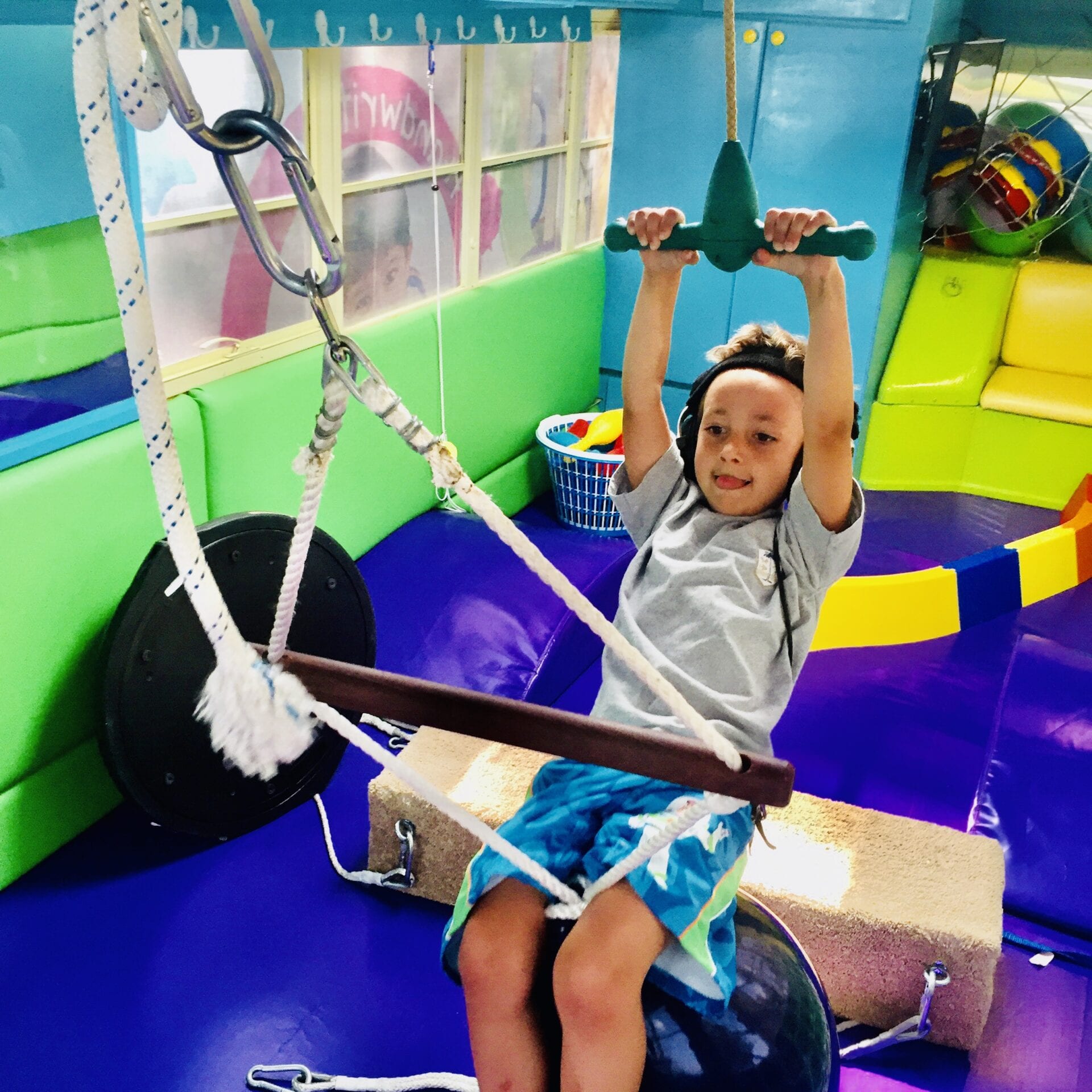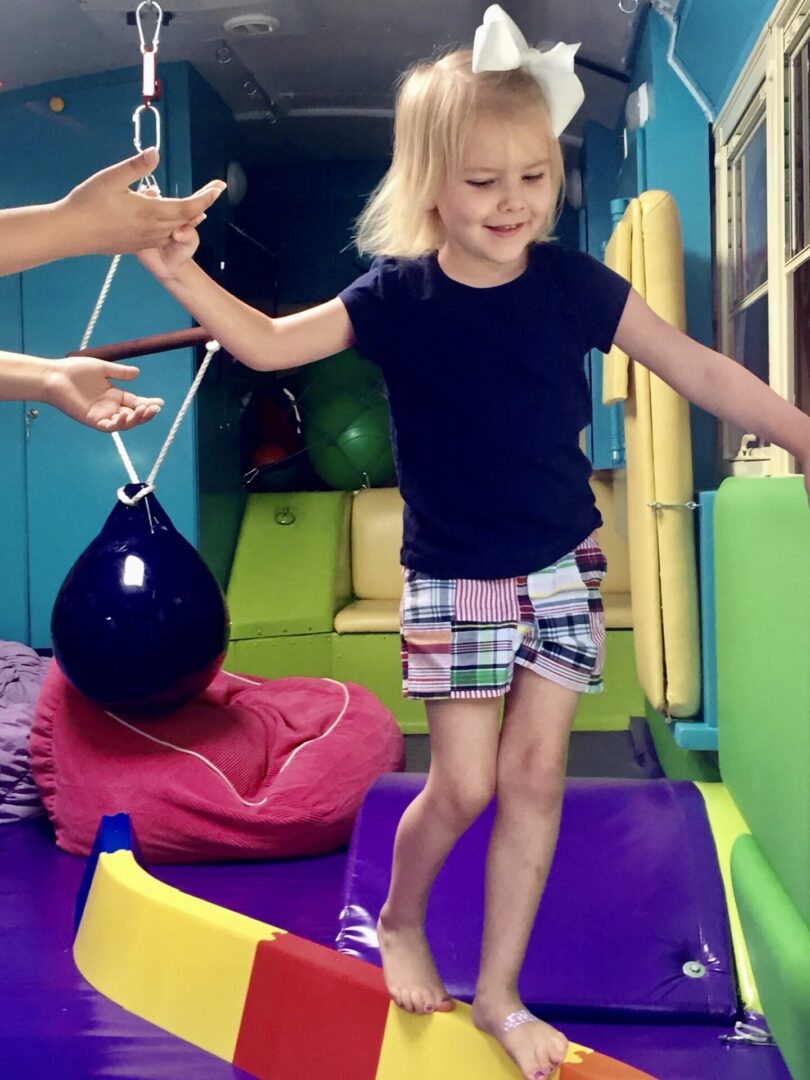Sensory Processing Disorder (SPD)
Whether you are biting into a hamburger, riding a bicycle, or reading a book, your successful completion of the activity requires processing sensation or "sensory integration." Sensory Processing, simply put, is the ability to take in information through our senses (touch, movement, smell, taste, vision, and hearing), put it together with prior information, memories and knowledge stored in the brain, and make a meaningful response.
Sensory Processing Disorder (SPD) is a condition that exists when signals in the brain don’t get organized into appropriate responses. Pioneering occupational therapist and neuroscientist, A. Jean Ayres, PhD, likened SPT to a neurological “traffic jam”.
If not treated effectively SPD can result in:
- Behavioral Problems
- Anxiety
- Depression
- School Failure
- Poor Self Concept
Being Labeled:
- Clumsy
- Uncooperative
- Disruptive
- “Out of Control”
Children With SPD Are Just As Intelligent As Their Peers
The Senses
The sense of position. It refers to perception of sensation from the muscles and joints. Proprioceptive input tells the brain when and how muscles are contracting or stretching, and when and how the joints are bending, extending or being pulled or compressed. This information enables the brain to know were each part of the body is and how it is moving.
Refers to the internal senses and responsible for detecting internal regulation responses, such as respiration, hunger, heart rate, and the need for digestive elimination.
Children with SPD do not respond to sensory information the way other children do. Their nervous systems may be constantly over-stimulated or under-stimulated. As a result, behaviors seen with SPD are typically categorized as either being “Hyper” (over-active) or “Hypo” (under-active). There is usually a combination of under-active and over-active behaviors present in a child with difficulties with sensory processing.
Sensory-seeking or obtaining behaviors characterize hyposensitivity, also known as hypo-responsiveness or under-sensitivity. The brain of the hyposensitive child registers sensations less intensely than those of others. This child requires more stimulation than other children to elicit similar responses. For example, a hypo-vestibular tactile child is never still. This child has a need to feel pressure and therefore is usually leaning on or over things, can be physically aggressive to other children, and has a high tolerance to pain. He also may be described as a “seeker” because he is seeking this type of sensory input.
Sensory avoiding or defensive behaviors characterize hypersensitivity, also known as hyper-responsiveness or oversensitivity. The brain of this child registers sensory activities or situations too intensely. Emotionally charged avoidance behaviors may occur: fright, flight, or fight. This child will avoid situations or activities that are viewed as threatening or rely on predictable activities or routines to decrease anxiety.
Motor Delays, Attention & Emotional Control
Hypersensitive:
- Avoid playground equipment
- Does not like being tipped upside down or having head inverted as in somersaults
- Afraid of falling
- Difficulty maneuvering over uneven surfaces
- Avoid rotating movements
- Avoid riding a bicycle, using skates
- May complain of feeling ill, get carsick or complain of headaches or stomachaches
Hyposensitive:
- Seek additional movement
- Have difficulty staying in their seat or sitting still
- Jump up and down, rock, or crave intense movement experiences
- Spin continually; rarely gets dizzy
- Can’t sit still
- Thrill seeker
- Dart from one activity to another
- Find their bodies loose and floppy
- Tire easily, slouch, and not have energy to move
- Have balance or coordination problems
- May not have consistent hand dominance
- May have difficulty with gaze stability, eye control, and visual perception
Hypersensitive:
- Avoid certain textures of clothing.
- Need tags removed from shirts.
- Avoid hair cutting, baths, or nail trimming
- Avoid crowded environment due to fear of being bumped
- Does not like to have hands dirty and will refuse messy play
- Resist cuddling or light touch
- Resistant to wearing socks and certain shoes
Hyposensitive:
- Repeatedly touches or feel things
- Frequently bump into people and objects
- Accident prone
- High threshold for pain (May even enjoy pain)
- Don’t realize their hands are dirty or their face is messy
- Play rough with peers
Hypersensitive:
- Push too hard, breaking toys or the lead of pencil when writing.
- Appear clumsy
- Difficulty understanding
- Gross motor skills appear awkward and uncoordinated
- Difficulty knowing where their body is in space
Hyposensitive:
- Press too lightly when writing, making it difficult to read
- May be aggressive with other children
- Love rough play
- Love to be squished and bear hugs
- Often crashing, jumping, and stomping
Hypersensitive:
- Cover ears to loud sounds
- Fearful of vacuums, hair dryers, public toilets flushing, lawn mowers
- Avoid or react to noisy public places (e.g., movies, restaurants, auditoriums, and even school cafeterias)
- Aware of sounds that others do not notice
Hyposensitive:
- Makes noises with their mouth (e.g., hums)
- Loves loud music
- Have difficulty determining where sound is coming from
- May not respond when their name is called
Hypersensitive:
- Picky eater
- Limit food to certain textures and excludes certain food groups (e.g., may exclude vegetables and some fruits).
- Have definite likes and dislikes with foods and is adamant
- Dislike tooth brushing and is very fearful of the Dentist
- May have difficulty with swallowing, chewing, sucking and even articulation
Hyposensitive:
- Prefer food with intense flavor or texture (e.g., chips, pickles, lemons, crunchy foods)
- Frequently chews on non-food items (buttons, collars, hair, shirt, pencils)
- Lick or mouth non-food items
- May drool
Hypersensitive:
- Notice all movement in classroom and is easily distracted
- Avoid eye contact
- May be bothered by bright lights or overly sensitive to sunlight
- Can become overly aroused in an overly decorated room (e.g.,
classroom or brightly colored room)
Hyposensitive:
- Mix up similar letters (e.g., “E” and “F” or “M “and N”)
- Lose place when reading or copying from the board
- Have difficulty with visual discrimination
- Have difficulty with visual pursuits (e.g., tracking an object)
Hypersensitive:
- Avoid playground equipment
- Does not like being tipped upside down or having head inverted as in somersaults
- Afraid of falling
- Difficulty maneuvering over uneven surfaces
- Avoid rotating movements
- Avoid riding a bicycle, using skates
- May complain of feeling ill, get carsick or complain of headaches or stomachaches
Hyposensitive:
- Seek additional movement
- Have difficulty staying in their seat or sitting still
- Jump up and down, rock, or crave intense movement experiences
- Spin continually; rarely gets dizzy
- Can’t sit still
- Thrill seeker
- Dart from one activity to another
Others may exhibit the following symptoms:
- Find their bodies loose and floppy
- Tire easily, slouch, and not have energy to move
- Have balance or coordination problems
- May not have consistent hand dominance
- May have difficulty with gaze stability, eye control, and visual perception
Hypersensitive:
- Avoid certain textures of clothing.
- Need tags removed from shirts.
- Avoid hair cutting, baths, or nail trimming
- Avoid crowded environment due to fear of being bumped
- Does not like to have hands dirty and will refuse messy play
- Resist cuddling or light touch
- Resistant to wearing socks and certain shoes
Hyposensitive:
- Repeatedly touches or feel things
- Frequently bump into people and objects
- Accident prone
- High threshold for pain (May even enjoy pain)
- Don’t realize their hands are dirty or their face is messy
- Play rough with peers
Hypersensitive:
- Push too hard, breaking toys or the lead of pencil when writing
- Appear clumsy
- Difficulty understanding
- Gross motor skills appear awkward and uncoordinated
- Difficulty knowing where their body is in space
Hyposensitive:
- Press too lightly when writing, making it difficult to read
- May be aggressive with other children.
- Love rough play
- Love to be squished and bear hugs
- Often crashing, jumping, and stomping
Hypersensitive:
- Cover ears to loud sounds
- Fearful of vacuums, hair dryers, public toilets flushing, lawn mowers
- Avoid or react to noisy public places (e.g., movies, restaurants, auditoriums, and even school cafeterias)
- Aware of sounds that others do not notice
Hyposensitive:
- Makes noises with their mouth (e.g., hums)
- Loves loud music
- Have difficulty determining where sound is coming from
- May not respond when their name is called
Hypersensitive:
- Picky eater
- Limit food to certain textures and excludes certain food groups (e.g., may exclude vegetables and some fruits).
- Have definite likes and dislikes with foods and is adamant
- Dislike tooth brushing and is very fearful of the Dentist
- May have difficulty with swallowing, chewing, sucking and even articulation
Hyposensitive:
- Prefer food with intense flavor or texture (e.g., chips, pickles, lemons, crunchy foods)
- Frequently chews on non-food items (buttons, collars, hair, shirt, pencils)
- Lick or mouth non-food items
- May drool
Hypersensitive:
- Notice all movement in classroom and is easily distracted
- Avoid eye contact
- May be bothered by bright lights or overly sensitive to sunlight
- Can become overly aroused in an overly decorated room (e.g.,
classroom or brightly colored room)
Hyposensitive:
- Mix up similar letters (e.g., “E” and “F” or “M “and N”)
- Lose place when reading or copying from the board
- Have difficulty with visual discrimination
- Have difficulty with visual pursuits (e.g., tracking an object)
Sensory Integration Treatment
One of our trained therapists guides a child through fun, structured activities that challenge the child to make successful, organized responses. Treatment typically takes place in a sensory rich environment as seen on The OT Bus™!
Over time, effective OT enables a child to play with friends, enjoy school, dressing, eating and even sleep well.
Left untreated SPD can persist into adulthood affecting an individual’s personal relationships, work, and social abilities.

If you have any questions or concerns regarding your child’s ability to adequately process sensory input, please contact us today for a FREE CONSULTATION!
Get Your Bus Ticket Today
Contact Us Today to Schedule an Evaluation for your “Rising Star!”

